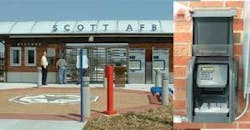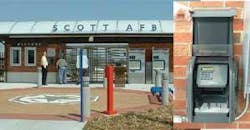By John McHale
SCOTT AIR FORCE BASE, Ill. - As part of a long-term test of biometric technology, officials of Scott Air Force Base (AFB), Ill., are using a hand-geometry system to improve base access through its Shiloh-Scott MetroLink rail station entrance.
A team of experts from the U.S. Department of Defense (DOD) Biometrics Fusion Center and West Virginia University recently visited Scott AFB to assess the hand-geometry system’s first year of operation. The team found that the system had not only performed well but had also saved money and manpower, say officials at the DOD Biometrics Management Office in Arlington, Va.
Scott AFB is home to the U.S. Transportation Command, Air Mobility Command, 18th Air Force, and the Air Force Communications Agency (AFCA).
Beginning in 2003, the base participated in a pilot project partially underwritten by the DOD Biometrics Management Office (BMO). Scott AFB acquired a biometric system to control base access at the new rail station entrance, which provides direct access to the base.
BMO leads the effort to adopt and institutionalize biometric technologies across the DOD. As the operational arm of the BMO, the Biometrics Fusion Center tests commercially available biometric technologies. The BMO reports to the Army Chief Information Officer who acts on behalf of the DOD Executive Agent for Biometrics, the Secretary of the Army.
Scott AFB sought to acquire a system at reasonable costs that could provide fast throughput, high reliability, and ease of use, BMO officials say. The Scott AFB system uses a combination of an enrolled user’s hand geometry with a personal identification number (PIN). This approach provides two-factor authentication-PIN and biometric.
The Scott AFB implementation team analyzed June to September 2003 performance data, during which the system had an uptime rate of 100 percent; enrollment time of less than two minutes on average; zero percent failure-to-enroll rate; 97.3 percent access rate; and 2.69 percent false reject rate.
There were no reported instances of a false accept, such as a nonenrolled individual successfully using the hand geometry device, BMO officials say. During the demonstration phase, several individuals tried to put in another user’s PIN and then place their hands on the platen; in all observed cases, the system blocked the individual’s access.
The system
The MetroLink access point uses a HandKey II hand geometry reader at each of two turnstiles. Hurricane enclosures protect the devices from bad weather, and integrated heaters protect gloveless users from the cold.
One of the turnstiles is large enough to accommodate wheelchairs and individuals carrying large or bulky items. Authentication begins when a user enters a six-digit PIN, which points to the enrolled biometric template, and then places a hand on the reader’s platen. Access is granted when the system determines that the stored template matches the hand on the platen. To leave the base, individuals move through one-way gates without presenting their biometric or identification card.
To enroll users in the system, an implementation team from HQ AFCA prepared to enroll more than 10,000 users who would use the MetroLink rail station entrance. The team collected data-including user name, status (such as retired, active, reserve), organization (such as AFCA, Security Forces Group), and phone number-for a database. The team also enrolled MetroBus and MetroLink drivers-with access time restrictions-in the system. An individual enrolls in the system by first verifying his or her identity.
A PIN is automatically generated from the user’s Social Security Number. The individual next places his or her hand on a hand-geometry reader’s platen three times to register a three-dimensional reading of the size and shape of the hand in the form of a nine-byte template, BMO officials say. The enrollment procedure requires no other information, and takes less than two minutes to complete.
In 2004 a team of West Virginia University researchers determined that the system could save the Air Force as much as $412,000 over five years.
They pegged the estimated cost of the hand-geometry system at $148,000 over five years, including expenses for maintenance and equipment upgrades. Of the estimated savings, a significant portion was derived from the redeployment of security guards.
The redeployment also relieved the guards from repetitive, mundane tasks such as badge monitoring, so that they are now available to deal with other important security issues.
Other unquantifiable benefits of the hand-geometry system included improvements in speed of entry, ease of access and use, and simplicity of access for the users.
To learn more about DOD Biometrics, visit www.biometrics.dod.mil.




